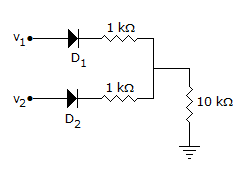Electronics and Communication Engineering - Analog Electronics - Discussion
Discussion Forum : Analog Electronics - Section 1 (Q.No. 7)
7.
In figure v1 = 8 V and v2 = 4 V. Which diode will conduct?


Answer: Option
Explanation:
D1 will conduct and the output voltage will be about 7 V. Therefore D2 will be reverse biased and will not conduct.
Discussion:
32 comments Page 3 of 4.
Priya said:
9 years ago
Thanks for the explanation @Nikkie.
Henna said:
8 years ago
How V is V/10?
Neha said:
8 years ago
@Nikkie
You will get V = 40/7 which is 5.7.
Hence, d1 will conduct and d2 will be reverse bias and won't conduct.
But from above statement how can tell that d1 will conduct?
You will get V = 40/7 which is 5.7.
Hence, d1 will conduct and d2 will be reverse bias and won't conduct.
But from above statement how can tell that d1 will conduct?
Mukesh said:
8 years ago
Thanks @Nikkie.
Mukkiii nautiyal said:
8 years ago
Simple apply kcl at the node.
V-8+v-4=v/10,
2v-12=v/10,
20v-120=v,
19v=120,
V=120/19,
V=6.31v.
You will get 6.31v at that node. So diode D1 is FB and D2 is Rb.
The answer should be B.
V-8+v-4=v/10,
2v-12=v/10,
20v-120=v,
19v=120,
V=120/19,
V=6.31v.
You will get 6.31v at that node. So diode D1 is FB and D2 is Rb.
The answer should be B.
Viji said:
7 years ago
Thanks @Mukkiii Nautiyal.
Artigo said:
7 years ago
@KCL.
i total = i1 + i2.
(V-8-0.7)/1k + (V-4-0.7)/1k = V/10k.
V = 7.05 so only D1 will conduct since it exceeds the threshold 7.05 and D2 is reverse biased.
i total = i1 + i2.
(V-8-0.7)/1k + (V-4-0.7)/1k = V/10k.
V = 7.05 so only D1 will conduct since it exceeds the threshold 7.05 and D2 is reverse biased.
Naveen said:
7 years ago
After Diode D1 conducts the potential creat at the junction between 1k and 10k is 6.36V (assume both diodes are Silicon diode) so at the diode, D2 anode potential is lesser than the cathode potential so D2 will not conduct.
So, Answer B is the right answer.
So, Answer B is the right answer.
Abhijit said:
7 years ago
(8-v)/1 +(4-v)/1=v/10,
v=5.71, where v is nodal voltage.
so D1 forward biased and D2 is reverse biased.
So, D1 is conducting.
v=5.71, where v is nodal voltage.
so D1 forward biased and D2 is reverse biased.
So, D1 is conducting.
Yussuf said:
5 years ago
i total = i1 + i2.
(V-8+0.7)/1k + (V-4+0.7)/1k = V/10k.
V = 5.05 so only D1 will conduct since it exceeds the threshold 5.05 and D2 is reverse biased.
(V-8+0.7)/1k + (V-4+0.7)/1k = V/10k.
V = 5.05 so only D1 will conduct since it exceeds the threshold 5.05 and D2 is reverse biased.
(2)
Post your comments here:
Quick links
Quantitative Aptitude
Verbal (English)
Reasoning
Programming
Interview
Placement Papers